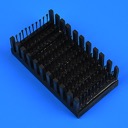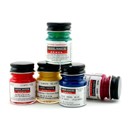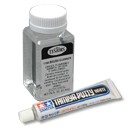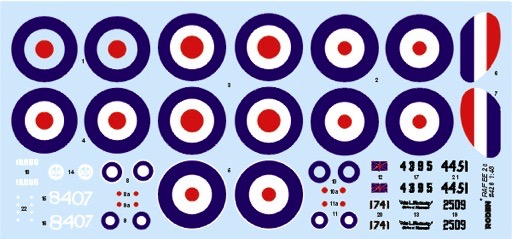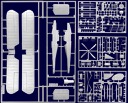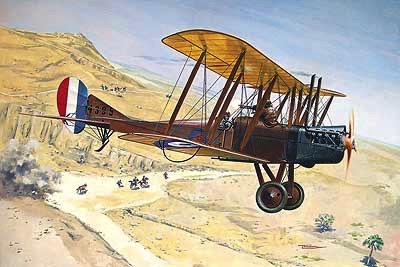

RAF BE.2c
Unassembled plastic model kit
Other products to consider
Don't forget building supplies!
Available(Ships in 2-4 business days)
This product is in stock
at our suppliers, if ordered it
will take a few days to arrive.List price: $45.99
You pay: $32.59
(All prices in U.S. Dollars)

Manufacturer: Roden
Stock Number: ROD 426
Scale: 1/48
View all products of type "Bristol BE2"
This product is in stock
at our suppliers, if ordered it
will take a few days to arrive.List price: $45.99
You pay: $32.59
(All prices in U.S. Dollars)


Manufacturer: Roden
Stock Number: ROD 426
Scale: 1/48
View all products of type "Bristol BE2"
This model kit requires assembly. Cement, paint and other construction materials not included unless specifically stated in the description.
Contains markings for:
The pace of development in aviation was such that the B.E.2 became obsolete in a matter of months. Edward Busk modified the construction of the B.E.2: the lower wing of the biplane was staggered rearwards in order to improve the observer's field of view, the form of the empennage was also changed, and the wings were fitted with ailerons. This new version was the B.E.2c and it was even more stable in flight than its predecessor. Both the Royal Flying Corps (RFC) and the Royal Naval Air Service (RNAS) requested the type. The Royal Aircraft Factory did not have the capacity to execute such an enormous order, and so licenses for its construction were given to such firms asBristol, Vickers, Armstrong Whitworth, Wolseley, Ruston Proctor and others. During 1914-1915 more than 2,000 B.E.2c's were built, along with the B.E.2d (which mainly differed from the B.E.2c in having anadditional fuel tank under the top wing).
The first B.E.2c appeared at the Front at the beginning of 1915. Its basic tasks in the sky of the Western Front were reconnaissance, artillery spotting, and the bombing of enemy troop formations. This variety of two seat aircraft, with an observer in the front cockpit and a pilot in the rear one, quickly became outmoded, and the B.E.2c lost more and more air battles to newer German two seaters. Its shortage of engine power restricted the scope for improvement, andthat is why the B.E.2c remained in the front line only for a short while. However, when the Sopwith 1-1/2 Strutter, De Havilland DH4 and Bristol Fighter appeared, its roles were limited to the interception of huge slow Zeppelins, and training. It should also be noted, that B.E.2c pilots from emergency flights destroyed at least five giant German Zeppelins. However they were already obsolete in 1917 even for the role of interceptor, and they gradually yielded their places to newer types. The only role left for the B.E.2c was in training, and at the end of WWI only a few machines of the type remained from more than 2,600 produced overall. By the beginning of the 1920s all of them haddisappeared for good, and the only B.E.2c remaining is in the Imperial War Museum in Great Britain. This exhibit, an extraordinarily elegant aircraft, is a rare living representative of the first few years of the war in the air.
- RAF BE2c "4395" No. 14 Squadron RFC (Expeditionary Forces), Arabian region, 1917.
- RAF BE2c "10000" The only British aircraft with five-numeral serial number, Blackburn-built. It was delivered to the RNAS Observers School Eastchurh, July 1917.
- RAF BE2c "1741" No. 12 Squadron RFC, Western Front, France, March 1916.
- RAF BE2c "2509" No. 2 Squadron RFC, presentation aircraft, it was paid for by Mrs. H.P.Stromberg of New York City, end of the 1916.
- RAF BE2c "8407" equipped with the Le Prieur rockets, aircraft based at Cranwell, early 1918.
- RAF BE2c "4451" early-built aircraft, based at Eastchurch and Grain, early 1916.
The pace of development in aviation was such that the B.E.2 became obsolete in a matter of months. Edward Busk modified the construction of the B.E.2: the lower wing of the biplane was staggered rearwards in order to improve the observer's field of view, the form of the empennage was also changed, and the wings were fitted with ailerons. This new version was the B.E.2c and it was even more stable in flight than its predecessor. Both the Royal Flying Corps (RFC) and the Royal Naval Air Service (RNAS) requested the type. The Royal Aircraft Factory did not have the capacity to execute such an enormous order, and so licenses for its construction were given to such firms asBristol, Vickers, Armstrong Whitworth, Wolseley, Ruston Proctor and others. During 1914-1915 more than 2,000 B.E.2c's were built, along with the B.E.2d (which mainly differed from the B.E.2c in having anadditional fuel tank under the top wing).
The first B.E.2c appeared at the Front at the beginning of 1915. Its basic tasks in the sky of the Western Front were reconnaissance, artillery spotting, and the bombing of enemy troop formations. This variety of two seat aircraft, with an observer in the front cockpit and a pilot in the rear one, quickly became outmoded, and the B.E.2c lost more and more air battles to newer German two seaters. Its shortage of engine power restricted the scope for improvement, andthat is why the B.E.2c remained in the front line only for a short while. However, when the Sopwith 1-1/2 Strutter, De Havilland DH4 and Bristol Fighter appeared, its roles were limited to the interception of huge slow Zeppelins, and training. It should also be noted, that B.E.2c pilots from emergency flights destroyed at least five giant German Zeppelins. However they were already obsolete in 1917 even for the role of interceptor, and they gradually yielded their places to newer types. The only role left for the B.E.2c was in training, and at the end of WWI only a few machines of the type remained from more than 2,600 produced overall. By the beginning of the 1920s all of them haddisappeared for good, and the only B.E.2c remaining is in the Imperial War Museum in Great Britain. This exhibit, an extraordinarily elegant aircraft, is a rare living representative of the first few years of the war in the air.

Copyright © 2005-2024 Scale Hobbyist, all rights reserved

















